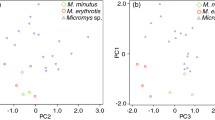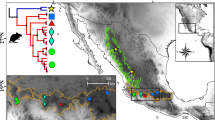Abstract
Gliridae is a small family of rodents including three subfamilies: the Eurasian Glirinae (with three genera) and Leithiinae (with four genera) and the African Graphiurinae (with a single genus). Phylogenetic relationships among these eight genera are not fully resolved based on morphological characters. Moreover, the genus Graphiurus is characterized by numerous peculiar features (morphological characters and geographical distribution), raising the question of its relationships to the family Gliridae. The phylogenetic position of Graphiurus and the intra-Gliridae relationships are here addressed by a molecular analysis of 12S RNA and cytochrome b mitochondrial gene sequences for six glirid genera. Phylogenetic analyses are performed with three construction methods (neighbor-joining, maximum parsimony and maximum likelihood) and tests of alternative topologies with respect to the most likely. Our analyses reveal that Graphiurus is clearly a member of the Gliridae, refuting the hypothesis that the family could be paraphyletic. Among Gliridae, phylogenetic relationships are poorly resolved: the Leithiinae could be monophyletic, there is no support for the subfamily Glirinae, and the closest relative of Graphiurus is not identified. The inclusion of Graphiurus among Gliridae allows us to postulate that its hystricomorphous condition has been achieved convergently with other hystricomorphous rodents.
Similar content being viewed by others
LITERATURE CITED
Anonymous (1998). Opinion 1894: Regnum Animale...; Ed. 2 (M. J. Brisson, 1762): rejected for nomenclatural purposes, with the conservation of the mammalian generic names Philander (Marsupialia), Pteropus (Chiroptera), Glis, Cuniculus, and Hydrochoerus (Rodentia), Meles, Lutra, and Hyena (Carnivora), Tapirus (Perissodactyla), Tragulus and Giraffa (Artiodactyla). Bull. Zool. Nomenclat. 55: 64–71.
Bachmayer, F., and Wilson, R. W. (1980). A third contribution to the fossil record small mammal fauna of Kohldfidish (Burgeland), Austria. Ann. Naturhistor. Mus. Wien 83: 351–386.
Bachmayer, F., and Wilson, R. W. (1987). Two additions to the Kohldfidish (Burgeland) fauna of Eastern Austria. Ann. Naturhistor. Mus. Wien 91: 1–5.
Barome, P.-O., Monnerot, M., and Gautun, J.-C. (1998). Intrageneric phylogeny of Acomys (Rodentia, Muridae) using mitochondrial gene cytochrome b. Mol. Phylogenet. Evol. 9: 560–566.
Bibb, M. J. R., Van Etten, A., Wright, C. T., Walberg, M. W., and Clayton, D. A. (1981). Sequence and gene organization of mouse mitochondrial DNA. Cell 26: 167–180.
Brandt, J. F. (1855). Beiträge zur nähern Kenntniss der Säugetiere Russlands. Mem. Acad. Imp. St. Petersbourg 9: 1–375.
Bremer, K. (1988). The limits of amino acid sequence data in angiosperm phylogenetic reconstruction. Evolution 42: 795–803.
Bugge, J. (1974). The cephalic arterial system in insectivores, primates, rodents and lagomorphs, with special reference to the systematic classification. Acta Anat. 87(Suppl. 62):1–160.
Bugge, J. (1985). Systematic value of the carotid arterial pattern in rodents, In: Evolutionary Relationships Among Rodents: A Multidisciplinary Analysis, W. P. Luckett, and J.-L. Hartenberger, eds., pp. 381–402, Plenum Press, New York.
Cao, Y., Adachi, J., and Hasegawa, M. (1998). Comment on the quartet puzzling method for finding maximum-likelihood tree topologies. Mol. Biol. Evol. 15: 87–89.
Catzeflis, F. M. (1991). Animal tissue collections for molecular genetics and systematics. Trends Ecol. Evol. 68: 168.
Catzeflis, F. M., Hänni, C., Sourrouille, P., and Douzery, E. (1995). Molecular systematics of hystricognath rodents: The contribution of sciurognath mitochondrial 12S rRNA sequences. Mol. Phylogenet. Evol. 4: 357–360.
Chaline, J., and Mein, P. (1979). Les Rongeurs et l'Evolution, DOIN, Paris.
Cunningham, C. W. (1997). Can three incongruence tests predict when data should be combined? Mol. Biol. Evol. 14: 733–740.
Daams, R., and De Bruijn, H. (1995). A classification of the Gliridae (Rodentia) on the basis of dental morphology. Proc. II. Conf. Dormice. Hystrix 6: 1–50.
Daams, R., and Van der Meulen, J. (1984). Paleoenvironmental and paleoclimatic interpretation of micromammal faunal successions in the Upper Oligocene and Miocene of the North Central Spain. Paléobiol. Cont. (Montpellier) 14: 241–257.
Douzery, E., and Catzeflis, F. M. (1995). Molecular evolution of the mitochondrial 12S rRNA in Ungulata (Mammalia). J. Mol. Evol. 41: 622–636.
Dubois, J.-Y., Rakotondravony, D., Hänni, C., Sourrouille, P., and Catzeflis, F. M. (1996). Molecular evolutionary relationships of three genera of Nesomyinae, endemic rodent taxa from Madagascar. J. Mammal. Evol. 3: 239–259.
Ellerman, J. R. (1940). The families and genera of modern rodents. Br. Mus. (Nat. Hist.) 1: 1–689.
Farris, J. S., Källersjö, M., Kluge, A. G., and Bult, C. (1995). Testing significance of incongruence. Cladistics 10: 315–319.
Felsenstein, J. (1985). Confidence limits on phylogenies: an approach using the bootstrap. Evolution 39: 783–791.
Frye, M. S., and Hedges, S. B. (1995). Monophyly of the order Rodentia inferred from mitochondrial DNA sequences of the genes for 12S rRNA, 16S rRNA, and tRNA-valine. Mol. Biol. Evol. 12: 168–176.
Galadeta, G. G., Pepe, G., De Candia, Quadriello, C., Sbisa, E., and Saccone, C. (1989). The complete nucleotide sequence of Rattus norvegicus: Cryptic signals revealed by comparative analysis between vertebrates. J. Mol. Evol. 28: 497–516.
Hänni, C., Laudet, V., Barriel, V., and Catzeflis, F. M. (1995). Evolutionary relationships of Acomys and other murids (Rodentia, Mammalia) based on complete 12S rRNA mitochondrial gene sequences. Israel J. Zool. 41: 131–146.
Hartenberger, J.-L. (1985). The order Rodentia: Major questions on their evolutionary origin, relationships and suprafamilial systematics. In: Evolutionary Relationships Among Rodents: A Multidisciplinary Analysis, W. P. Luckett, and J.-L. Hartenberger, eds., pp. 1–33, Plenum Press, New York.
Hartenberger, J.-L. (1994). The evolution of the Gliroidea. In: Rodent and Lagomorph Families of Asian Origins and Diversification, C. K. Li, Y. Tomida, and T. Setoguchi, eds., pp. 19–33, National Science Museum Monographs, Tokyo.
Hendey, Q. B. (1981). Paleoecology of the late Tertiary fossil occurrences in “E” Quarry, Langebaanweg, South Africa, and a reinterpretation of their geological context. Ann. S. Afr. Mus. 84: 1–104.
Hillis, D. M., and Huelsenbeck, J. P. (1992). Signal, noise, and reliability in molecular phylogenetic analyses. J. Hered. 83: 189–195.
Holden, M. E. (1993). Family Myoxidae. In: Mammal Species of the World, a Taxonomic and Geographic Reference, D. E. Wilson, and D. M. Reeder, eds., pp. 763–770, Smithsonian Institution Press, Washington, DC.
Holden, M. H. (1996). Systematic revision of subsaharan African dormice (Rodentia: Myoxidae: Graphiurus). Part I. An introduction to the generic revision, and a revision of Graphiurus surdus. Am. Mus. Novit. 3157: 1–44.
Jaeger, J.-J. (1977). Les rongeurs du Miocène moyen et supérieur du Maghreb. Palaeovertebrata 8: 1–166.
Kishino, H., and Hasegawa, M. (1989). Evaluation of the maximum likelihood estimate of the evolutionary tree topologies from DNA sequence data, and the branching order in Hominoidea. J. Mol. Evol. 29: 170–179.
Koenigswald, W. v. (1992). Die Schmelzmuster in den Schneidezähnen der Gliroidea (Gliridae und Seleviniidae, Rodentia, Mammalia) und ihre systematische Bedeutung. Z. Saügetierkunde 58: 92–115.
Lara, M. C., Patton, J. L., and Da Silva, M. N. F. (1996). The simultaneous diversification of South American echimyid rodents (Hystricognathi) based on complete cytochrome b sequences. Mol. Phylogenet. Evol. 5: 403–413.
Lecointre, G., Philippe, H., Lê, H. L. V., and Le Guyader, H. (1993). Species sampling has a major impact on phylogenetic inference. Mol. Phylogenet. Evol. 2: 205–224.
Ma, D.-P., Zharkikh, A., Graur, D., VandeBerg, J. L., and Li, W.-H. (1993). Structure and evolution of opossum, guinea pig, and porcupine cytochrome b genes. J. Mol. Evol. 36: 327–334.
Maier, W., and Schrenk, F. (1987). The hystricomorphy of the Bathyergidae, as determined from ontogenetic evidence. Z. Saügetierk. 52: 156–164.
Montgelard, C., Catzeflis, F. M., and Douzery, E. (1997). Phylogenetic relationships of artiodactyls and cetaceans as deduced from the comparison of cytochrome b and 12S rRNA mitochondrial sequences. Mol. Biol. Evol. 14: 550–559.
Nedbal, M. A., Honeycutt, R. L., and Schlitter, D. A. (1996). Higher-level systematics of rodents (Mammalia, Rodentia): Evidence from the mitochondrial 12S rRNA gene. J. Mammal. Evol. 3: 201–237.
Parent, J.-P. (1980). Recherche sur l'oreille moyenne des rongeurs actuels et fossiles: Anatomie, valeur systématique. Mem. Trav. E.P.H.E. (Montpellier) 11: 1–286.
Philippe, H. (1993). MUST: A computer package of management utilities for sequences and trees. Nucleic Acids Res. 21: 5264–5272.
Philippe, H. (1997). Rodent monophyly: Pitfalls of molecular phylogenies. J. Mol. Evol. 45: 712–715.
Philippe, H., and Douzery, E. (1994). The pitfalls of molecular phylogeny based on four species as illustrated by the Cetacea/Artiodactyla relationships. J. Mammal. Evol. 2: 133–152.
Pocock, T. N. (1976). Pliocene mammalian microfauna from Langebaanweg: A new fossil genus linking the Otomyinae with the Murinae. South Afr. J. Sci. 72: 58–60.
Reyes, A., Pesole, G., and Saccone, C. (1998). Complete mitochondrial DNA sequence of the fat dormouse, Glis glis: Further evidence of rodent paraphyly. Mol. Biol. Evol. 15: 499–505.
Robinson, M., Catzeflis, F. M., Briolay, J., and Mouchiroud, D. (1997). Molecular phylogeny of rodents, with special emphasis on murids: Evidence from nuclear gene LCAT. Mol. Phylogenet. Evol. 8: 423–434.
Saitou, N., and Nei, M. (1987). The neighbor-joining method: A new method for reconstructing phylogenetic trees. Mol. Biol. Evol. 4: 406–425.
Sambrook, J., Fritsch, E. F., and Maniatis, T. (1989). Molecular Cloning, Cold Spring Harbor Laboratory Press, Cold Spring Harbor, NY.
Siddal, M. (1996). Random cladistics. Version 4.0. Virginia Institute of Marine Science, College of William and Mary, Gloucester Point, VA 23062 (anonymous ftp://zoo.toronto.edu/pub).
Simpson, G. G. (1945). The principles of classification and a classification of mammals. Bull. Am. Mus. Nat. His. 85: 1–350.
Springer, M. S., and Douzery, E. (1996). Secondary structure and patterns of evolution among mammalian mitochondrial 12S rRNA molecules. J. Mol. Evol. 43: 357–373.
Strimmer, K., and von Haeseler, A. (1996). Quartet puzzling: A quartet maximum-likelihood method for reconstructing tree topologies. Mol. Biol. Evol. 13: 964–969.
Sullivan, J., and Swofford, D. L. (1997). Are guinea pigs rodents? The importance of adequate models in molecular phylogenetics. J. Mammal. Evol. 4: 77–86.
Suzuki, H., Minato, S., Sakurai, S., Tsuchiya, K., and Fokin, I. M. (1997). Phylogenetic position and geographic differentiation of the Japanese dormouse, Glirulus japonicus, revealed by variations among rDNA, mtDNA and the Sry gene. Zool. Sci. 14: 167–173.
Swofford, D. L. (1993). PAUP 3.1.1: Phylogenetic Analysis Using Parsimony, Version 3.1.1. Computer program distributed by the Illinois Natural History Survey, Champaign.
Tamura, K., and Nei, M. (1993). Estimation of the number of nucleotide substitutions in the control region of mitochondrial DNA in humans and chimpanzees. Mol. Biol. Evol. 10: 512–526.
Tullberg, T. (1899). Ueber das System der Nagetiere: Eine phylogenetische studie. Nova Acta Reg. Soc. Sci. Uppsala Ser. 3 18: 1–514.
Vachontov, E. L., and Potapova, E. G. (1991). On the position of dormice (Gliroidea) in the system of rodents. Proc. Zool. Inst. 243: 127–147.
Vianey-Liaud, M. (1985). Possible evolutionary relationships among Eocene and lower Oligocene rodents in Asia, Europe and North America, In: Evolutionary Relationships Among Rodents: A Multidisciplinary Analysis, W. P. Luckett, and J.-L. Hartenberger, eds., pp. 277–309, Plenum Press, New York.
Vianey-Liaud, M., and Jaeger, J. J. (1996). A new hypothesis for the origin of African Anomaluridae and Graphiuridae (Rodentia). Palaeovertebrata 25: 349–358.
Vianey-Liaud, M., Jaeger, J.-J., Hartenberger, J.-L., and Mahboudi, M. (1994). Les rongeurs de l'Eocène d'Afrique Nord-Occidentale (Glib Zegdou (Algérie) et Chambi (Tunisie)) et l'origine des Anomaluridae. Palaeovertebrata 23: 93–118.
Wahlert, J. H., Sawitzke, S. L., and Holden, M. E. (1993). Cranial anatomy and relationships of dormice (Rodentia, Myoxidae). Am. Mus. Novit. 3061: 1–32.
Wettstein, P. J., Strausbauch, M., Lamb, T., States, J., Chackraborty, R., Jin, L., and Riblet, R. (1995). Phylogeny of six Sciurus aberti subspecies based on nucleotide sequences of cytochrome b. Mol. Phylogenet. Evol. 4: 150–162.
Wilson, D. E., and Reeder, D. M. (1993). Mammal Species of the World: A Taxonomic and Geographic Reference, Smithsonian Institution Press, Washington, DC, and London.
Winge, H. (1941). The Interrelationships of the Mammalian Genera. Rodentia, Carnivora, Primates, C. A. Reitzels Forlag, Copenhagen.
Wood, A. E. (1937). The mammalian fauna of the White River Oligocene. Part II. Rodentia. Trans. Am. Phil. Soc. N.S. 28: 155–269.
Wood, A. E. (1985). The relationships, origin and dispersal of the hystricognathous rodents. In: Evolutionary Relationships Among Rodents: A Multidisciplinary Analysis, W. P. Luckett, and J.-L. Hartenberger, eds., pp. 475–513, Plenum Press, New York.
Author information
Authors and Affiliations
Corresponding author
Rights and permissions
About this article
Cite this article
Bentz, S., Montgelard, C. Systematic Position of the African Dormouse Graphiurus (Rodentia, Gliridae) Assessed from Cytochrome b and 12S rRNA Mitochondrial Genes. Journal of Mammalian Evolution 6, 67–83 (1999). https://doi.org/10.1023/A:1020590430250
Issue Date:
DOI: https://doi.org/10.1023/A:1020590430250




